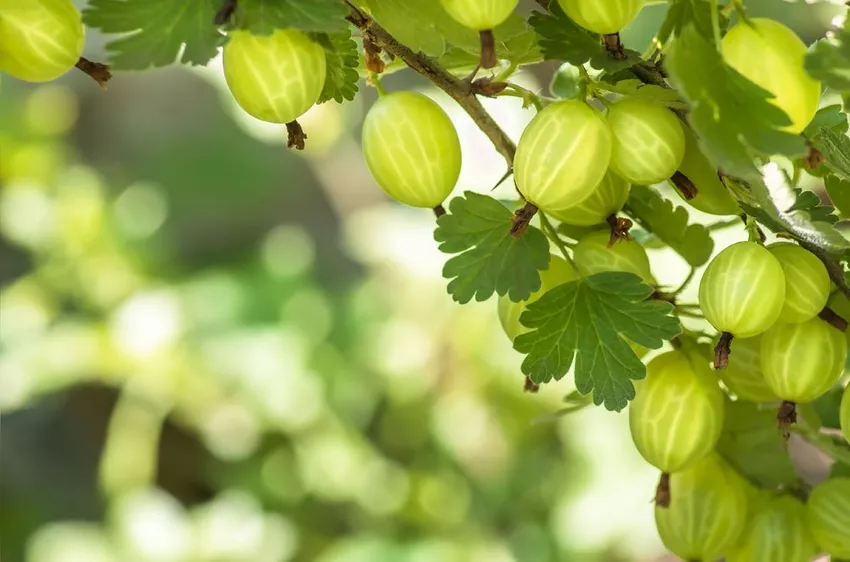In this article you can find out how to plant gooseberries and when is the best time. We also have a few care tips for you.

Gooseberries are high in vitamin C
The gooseberry (Ribes uva-crispa), which is closely related to the currant, also thrives extremely well in our latitudes and delights us with sweet and sour-tasting fruits in summer. Both on the cake and freshly picked, these little berries taste extraordinarily delicious.
So just try it and plant gooseberries yourself and enjoy the juicy berries in summer.
There are different types of plants
Bush or standard tree?
Before planting a gooseberry, you need to decide which varieties you want to plant in the first place. In the garden store, the gooseberry is usually offered as a bush or as a standard tree - both variants are also suitable for keeping in containers on the balcony and terrace. Both growth forms are available with white, yellowish, green and red fruits.
However, you have to make sure that tall stems always have to be supported with posts in order to be able to carry the weight of the fruit in autumn without any problems. You also have to take into account that the stems usually have a much lower yield than the more robust bush plants (up to 5 kilograms per mature perennial).
Crossbreeds and new breeds
You can also buy a combination plant (crossbreed) of currant and gooseberry, the so-called Josta berry plant, from specialist retailers. No matter which variety you finally choose, always make sure that you buy mildew-resistant plants, such as red Pax or Redeva and Remarka, green Invicta or yellow Hinnomäki or Resistenta, etc.

» Tip:
Numerous new breeds meanwhile also ensure the harvest of purely sweet-tasting fruits (high fructose content), as well as fewer thorny outgrowths on the stem (partially thorn-free) and berries with only minimal fruit hairs.
Gooseberries - 3 popular varieties
❍ Prickly Gooseberry 'Captivator':

| Prickly Gooseberry 'Captivator' (Ribes uva-crispa 'Captivator') | |
|---|---|
| Growth Speed: | 10 - 30 cm a year |
| Growth: | 60 - 120 cm |
| Growth: | 60 - 120 cm |
| Root system: | Shallow roots |
| Location: | Sun to partial shade |
| Floor: | humic, well-drained, loamy-sandy garden soil |
❍ Gooseberry 'Hinnonmäki yellow':

| Gooseberry 'Hinnonmäki yellow' (Ribes uva-crispa 'Hinnonmäki yellow') | |
|---|---|
| Growth Speed: | 10 - 30 cm a year |
| Growth: | 60 - 120 cm |
| Growth: | 60 - 120 cm |
| Root system: | Shallow roots |
| Location: | Sun to partial shade |
| Floor: | normal garden soil |
❍ Gooseberry 'Invicta':

| Gooseberry 'Invicta' (Ribes uva-crispa 'Invicta') | |
|---|---|
| Growth Speed: | 10 - 30 cm a year |
| Growth: | 60 - 120 cm |
| Growth: | 60 - 120 cm |
| Root system: | Shallow roots |
| Location: | Penumbra |
| Floor: | normal garden soil |
Planting gooseberries - How it's done
Location:
The gooseberry generally prefers a sunny, sheltered location. But beware: the perennials should not be exposed to the blazing sun (moderately semi-shaded).
» Tip:
The gooseberries, which have a high vitamin C content, should best be planted on an east/south side, or in the middle of other shrubs that can give them some shade.
Planting time:
You should plant the gooseberry either in spring or in autumn. New cultivars are even suitable as espalier fruit plants!

Caring for gooseberries
Cut:
The hardy gooseberries are among the easy-care fruit trees whose flowers only need to be protected from late frosts. You also need to trim old branches that are too close together regularly after harvest or early in the spring.
» Tip:
A bold pruning for rejuvenation also protects some plants for yearsPests and Diseases.
Fertilize:
You should fertilize the berry bushes in autumn and/or spring by working in compost around the bush. You can also supply the plants with special berry fertilizer at regular intervals, from spring to early summer.
Harvest Gooseberries
You can harvest the gooseberries - depending on the variety - when the fruits are ripe (from around the end of June to August). Incidentally, you can recognize ripe fruits by their unmistakable taste and the color of the fruit.
» Tip:
You can also harvest the gooseberries when they are unripe. They are the only type of berry that can ripen without any problems.
Questions about gooseberries
How do gooseberries taste?
Depends on the variety, but most gooseberries have a sour taste. The riper the gooseberries become, the softer their otherwise firm skin becomes and the taste becomes sweeter.
Planting gooseberries - when?
The best time to plant gooseberries is spring, but also autumn. Do not plant the gooseberries in direct sunlight and ensure they are sheltered from the wind.
When are gooseberries harvested?
Most gooseberry varieties are ripe in summer and can be harvested between June and August.
How tall does a gooseberry bush grow?
The average height of a gooseberry bush is 120 cm. But there are also specimens that can reach a height of 150 cm.
When should you fertilize gooseberries?
The gooseberry bush can be fertilized after flowering, i.e. in May. The fertilizer (compost, horn shavings) is scattered around the shrub and worked into the soil.